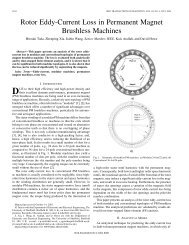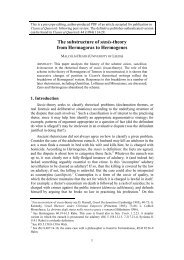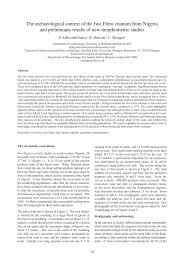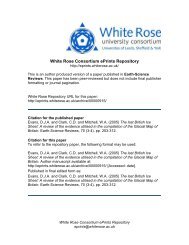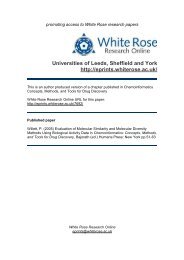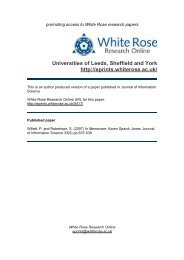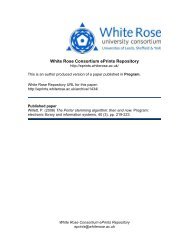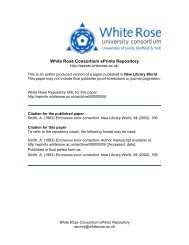The last British Ice Sheet: A review of the evidence utilised in the ...
The last British Ice Sheet: A review of the evidence utilised in the ...
The last British Ice Sheet: A review of the evidence utilised in the ...
Create successful ePaper yourself
Turn your PDF publications into a flip-book with our unique Google optimized e-Paper software.
<strong>The</strong> L<strong>in</strong>ton-Stutton gravels occur outside <strong>the</strong> Escrick mora<strong>in</strong>e between Tadcaster and We<strong>the</strong>rby and form<br />
an extensive but discont<strong>in</strong>uous spread <strong>of</strong> ice-contact gravel mounds with subdued relief. Sections show<br />
extensive deformation and <strong>the</strong>y are thought to have formed at an earlier stage <strong>of</strong> <strong>the</strong> <strong>last</strong> glaciation than <strong>the</strong><br />
York–Escrick mora<strong>in</strong>es (Edwards et al., 1950). <strong>The</strong>se deposits were <strong>in</strong>terpreted as a kame by Edwards et al.<br />
(1950) but as an esker north <strong>of</strong> Bramham by Straw (1979). Straw (1979) suggested a submarg<strong>in</strong>al (or<br />
<strong>in</strong>terlobate?) orig<strong>in</strong> for this “esker” associated with <strong>the</strong> Nidderdale Glacier, which was deflected over<br />
Harrogate by <strong>the</strong> Vale <strong>of</strong> York lobe dur<strong>in</strong>g a pre-Escrick phase [Early Ma<strong>in</strong> Dales Glaciation <strong>of</strong> Edwards<br />
(1938)]. Lateral meltwater channels along <strong>the</strong> former western marg<strong>in</strong> <strong>of</strong> <strong>the</strong> Vale <strong>of</strong> York lobe were mapped<br />
by Kendall and Wroot (1924) and Melmore and Harrison (1934). Where <strong>the</strong>se lay outside <strong>the</strong> York–Escrick<br />
limits and <strong>in</strong> association with <strong>the</strong> L<strong>in</strong>ton-Stutton gravels, <strong>the</strong>y were regarded as pre-LGM. <strong>The</strong> diversion <strong>of</strong><br />
<strong>the</strong> River Wharfe was associated with <strong>the</strong> construction <strong>of</strong> <strong>the</strong> Escrick mora<strong>in</strong>e because it now occupies a<br />
course that follows <strong>the</strong> distal side <strong>of</strong> <strong>the</strong> mora<strong>in</strong>e and does not follow its preglacial course. Gaunt (1981)<br />
suggested that <strong>the</strong> Vale <strong>of</strong> York lobe <strong>in</strong>itially advanced as a surge <strong>in</strong>to Glacial Lake Humber all <strong>the</strong> way to<br />
Wroot <strong>in</strong> L<strong>in</strong>colnshire based on one ma<strong>in</strong> l<strong>in</strong>e <strong>of</strong> <strong>evidence</strong>, <strong>the</strong> “Wroot Thorne Gravels”. <strong>The</strong> marg<strong>in</strong> later<br />
stabilized at <strong>the</strong> York and Escrick mora<strong>in</strong>es when <strong>the</strong> level <strong>of</strong> Glacial Lake Humber dropped. Straw (1979)<br />
had previously proposed that <strong>the</strong> till to <strong>the</strong> south <strong>of</strong> <strong>the</strong> York and Escrick mora<strong>in</strong>es was “older”, probably<br />
early Devensian <strong>in</strong> age. <strong>The</strong>re has however been cont<strong>in</strong>ued debate regard<strong>in</strong>g <strong>the</strong> existence <strong>of</strong> this surge and <strong>in</strong><br />
a recent <strong>review</strong> <strong>of</strong> <strong>the</strong> possible <strong>evidence</strong> for such an event, Straw (2002) rejects this sequence <strong>of</strong> events and<br />
argued that <strong>the</strong> stratigraphic record south <strong>of</strong> <strong>the</strong> Escrick mora<strong>in</strong>e is pre-Devensian and that <strong>the</strong> <strong>last</strong> ice sheet<br />
limit <strong>in</strong> <strong>the</strong> Vale <strong>of</strong> York is at Escrick. A lower stage Lake Humber is recorded by <strong>in</strong>terdigitation <strong>of</strong> lake<br />
sediments (<strong>the</strong> “25 foot drift”) and <strong>the</strong> till and gravels <strong>of</strong> <strong>the</strong> Escrick Mora<strong>in</strong>e, demonstrat<strong>in</strong>g that <strong>the</strong> mora<strong>in</strong>e<br />
was deposited at an ice-contact lake marg<strong>in</strong> (Gaunt, 1970).<br />
A prom<strong>in</strong>ent hummocky mora<strong>in</strong>e on Flamborough Head was identified by Farr<strong>in</strong>gton and Mitchell (1951)<br />
who regarded it as an end mora<strong>in</strong>e. This mora<strong>in</strong>e assemblage widens and stretches northwards to Speeton and<br />
<strong>the</strong>n to Cayton where it has been called <strong>the</strong> Speeton mora<strong>in</strong>e by Valent<strong>in</strong> (1957), who allocated it to a<br />
“second readvance” on Holderness. Specifically, <strong>the</strong> prom<strong>in</strong>ent mora<strong>in</strong>ic relief was <strong>the</strong> result <strong>of</strong> <strong>the</strong><br />
compression <strong>of</strong> ridges aga<strong>in</strong>st <strong>the</strong> chalk scarp and <strong>the</strong> overrid<strong>in</strong>g <strong>of</strong> “first readvance” deposits. This was later<br />
termed <strong>the</strong> “Cayton-Speeton Stage” by Straw (1979). <strong>The</strong> Flamborough Mora<strong>in</strong>e to <strong>the</strong> south was allocated<br />
to <strong>the</strong> “Seamer-Flamborough Stage” by Penny and Rawson (1969) who referred to <strong>the</strong> l<strong>in</strong>earity <strong>in</strong> <strong>the</strong><br />
mora<strong>in</strong>e at Reighton as possible druml<strong>in</strong>s. Fur<strong>the</strong>r south on Holderness, Valent<strong>in</strong> (1957) traced a l<strong>in</strong>e<br />
connect<strong>in</strong>g <strong>the</strong> outcrops <strong>of</strong> <strong>the</strong> Kelsey Hill Gravels at Burton Agnes, Brandesburton, Bilton and Patr<strong>in</strong>gton<br />
out to <strong>the</strong> North Sea, which he regarded as a product <strong>of</strong> <strong>the</strong> “second readvance”; this l<strong>in</strong>e also encloses <strong>the</strong><br />
extent <strong>of</strong> <strong>the</strong> Wi<strong>the</strong>rnsea (Purple) Till (see Section 2.3). Outside this limit <strong>the</strong> marg<strong>in</strong>s <strong>of</strong> <strong>the</strong> “first readvance”<br />
are marked by subdued mora<strong>in</strong>ic ridges at Routh, Wawne and Sutton (Straw, 1979). <strong>The</strong> high land at<br />
22




